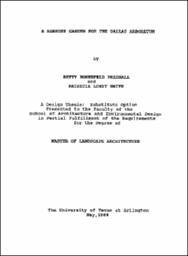
ATTENTION: The works hosted here are being migrated to a new repository that will consolidate resources, improve discoverability, and better show UTA's research impact on the global community. We will update authors as the migration progresses. Please see MavMatrix for more information.
Show simple item record
| dc.contributor.advisor | Windham, Oliver | |
| dc.contributor.advisor | DeJean, Robert | |
| dc.contributor.advisor | Myrick, Richard B | |
| dc.contributor.advisor | James, G Truett | |
| dc.contributor.advisor | Baum, Edward M | |
| dc.contributor.author | Presnall, Betty Bornefeld | |
| dc.contributor.author | Smith, Patricia Lobit | |
| dc.date.accessioned | 2019-06-11T18:08:15Z | |
| dc.date.available | 2019-06-11T18:08:15Z | |
| dc.date.issued | 1988-05 | |
| dc.identifier.uri | http://hdl.handle.net/10106/28207 | |
| dc.description.abstract | Design is most often carried out as an aesthetic exercise in visual affect and spatial treatment. If more stimulation of other human senses (orienting, auditory, smell / taste, visual, and haptic) were to occur in a place, perhaps the place would become more meaningful and memorable. In an effort to address this hypothesis, a Sensory Garden was designed, and hopefully will be implemented. As far as can be determined no other gardens in the United States exist which were designed explicitly to stimulate all the senses. There is a Fragrance Garden at the Strybing Arboretum at Golden Gate Park in San Francisco, and several Gardens for the Blind exist in San Antonio and Fort Worth, Texas. | en_US |
| dc.language.iso | en_US | en_US |
| dc.publisher | University of Texas at Arlington | en_US |
| dc.subject | sensory gardens | en_US |
| dc.subject | Dallas Arboretum, Dallas, Texas | en_US |
| dc.title | A Sensory Garden for the Dallas Arboretum | en_US |
| dc.type | Thesis | en_US |
Files in this item
- Name:
- Sensory Garden for the Dallas ...
- Size:
- 36.08Mb
- Format:
- PDF
- Description:
- A Sensory Garden for the Dallas ...
This item appears in the following Collection(s)
Show simple item record


